Cubed Turnip Kimchi Kkakdugi With Carrots
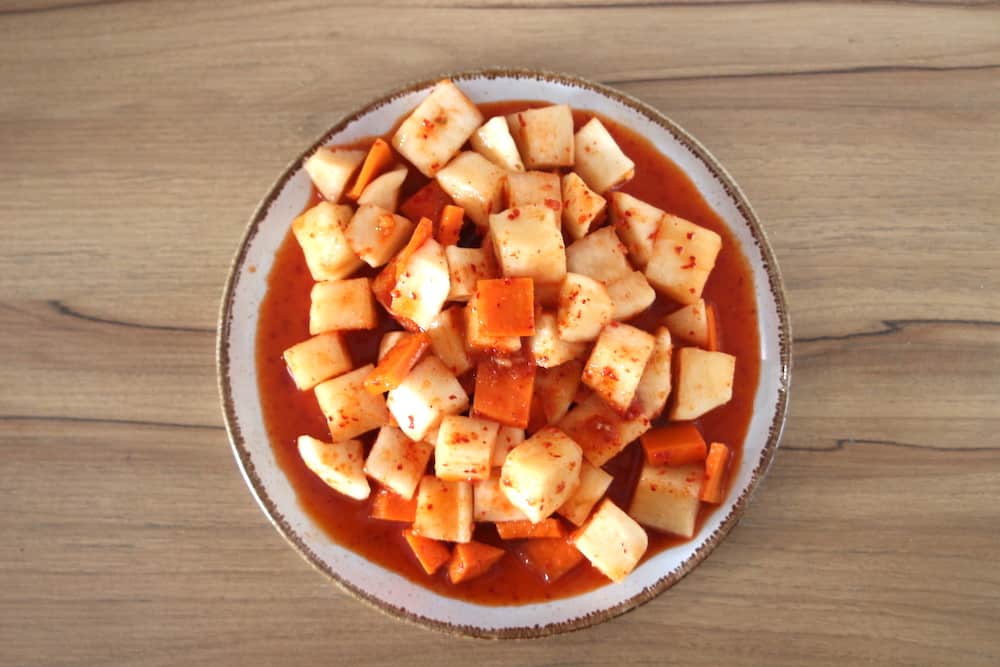
As an expert gut nutritionist with years of experience making kimchi, I can assure you that this recipe is both delicious and packed with health benefits.
In this recipe, I've used white turnips, also known as daikon, along with carrots and a thick, spicy paste made from garlic chives, Korean gochugaru flakes, garlic, fish sauce, water, and ginger.
My tip is to use ginger sparingly, as it can be overpowering. This recipe does not contain vinegar, allowing the kimchi to ferment and produce probiotic bacteria, which is what my blog, Probiotic Review Girl, is all about.
Trust me when I say that this turnip kimchi is easy to make, super healthy, and tastes great!
Turnip Kimchi Ingredients
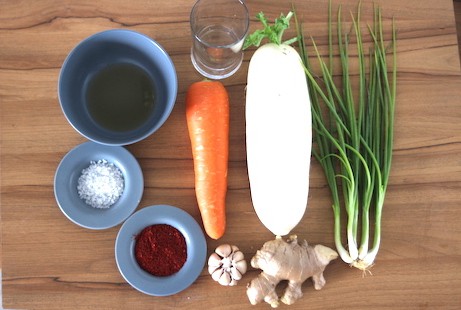
This Turnip Kimchi recipe is a simple and delicious dish that doesn't require a lot of ingredients. The main components are white turnips (or daikon) and some carrots. For the Kimchi paste, you'll need garlic chives, Korean Gochugaru flakes, garlic, fish sauce, water, and ginger. PS. If you love carrots, don't miss out on my carrot Kimchi recipe.
The exact ingredients for my Turnip Kimchi are listed below.
One tip for making this recipe is to use ginger sparingly, as it can easily overpower the other flavors. The most challenging part of making this dish is typically getting enough sauce to coat the vegetables evenly, but if you follow the recommended measurements, you should have no problems.
If you prefer a sweeter flavor, you can add a teaspoon of sugar to the recipe. Overall, this Turnip Kimchi recipe is quick and easy to prepare and offers a tasty and healthy way to enjoy these nutritious vegetables.
Step By Step Turnip Kimchi Directions
The step by step directions for making my Turnip Kimchi are listed below with easy to follow images.
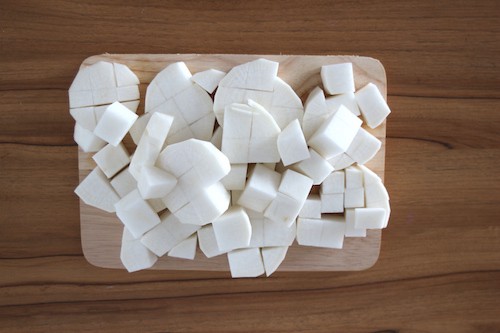
- To prepare your white turnips for the recipe, begin by slicing them into small, bite-sized cubes. It's important to rinse the turnips thoroughly before slicing to ensure that any dirt or debris is removed. If you notice any dirt still stuck on the turnip, gently scrub it away under running water before slicing.
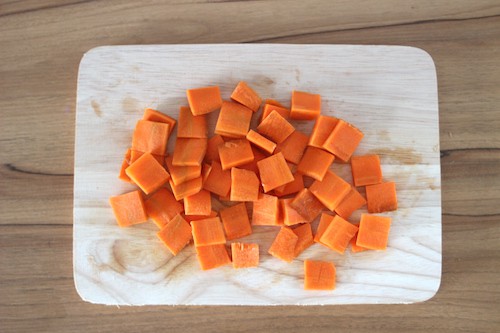
- For my turnip kimchi recipe, I like to add some diced carrots for a touch of sweetness. If you decide to use carrots, make sure to rinse them well and slice them into small cubes before adding them to the mix. I find this helps ensure they are evenly distributed throughout the kimchi and add a delicious crunch to the final dish. However, if you prefer to omit the carrots, you can still enjoy a delicious and flavorful turnip kimchi.
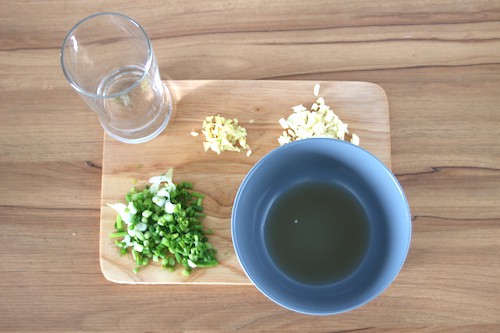
- To prepare the turnips and carrots for the kimchi, start by placing the sliced vegetables into a clean bowl and add salt. Let the vegetables sit for about 30 minutes to an hour until you see a pool of water has formed at the bottom of the bowl. Once this happens, rinse the vegetables thoroughly with clean water and dry them in a separate bowl before adding the kimchi paste.
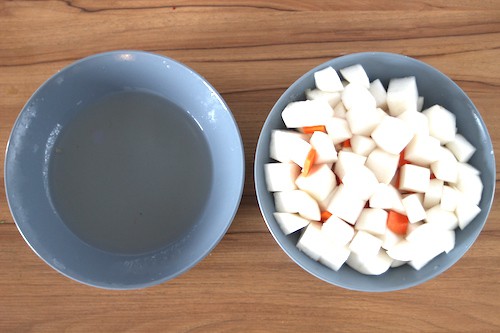
30 Minutes Later
- While the vegetables are salting and undergoing the lacto-fermentation process, it's a good time to prepare the kimchi paste. The paste for this recipe is made with garlic chives, ginger, garlic, and a small amount of water to thin it out if needed.
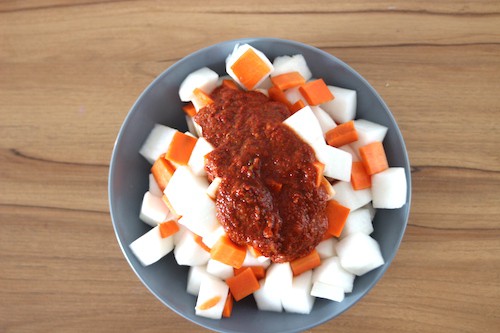
- Once you have blended the garlic chives, ginger, garlic, and water, you should have a smooth and paste-like consistency. This is what the Turnip Kimchi Paste should look like. Now, pour the paste on top of the sliced turnips and carrots, making sure to cover all of the vegetables. Use your hands or a spoon to mix the vegetables and the paste thoroughly.
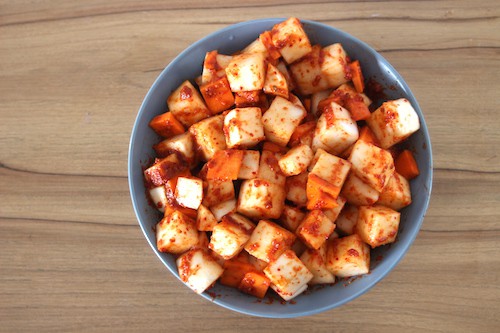
- To ensure that the kimchi paste is evenly distributed, use a spoon, plastic gloves, or clean hands to mix it thoroughly through the turnips and carrots. Be sure to mix it well, ensuring that the paste covers every part of the vegetables.
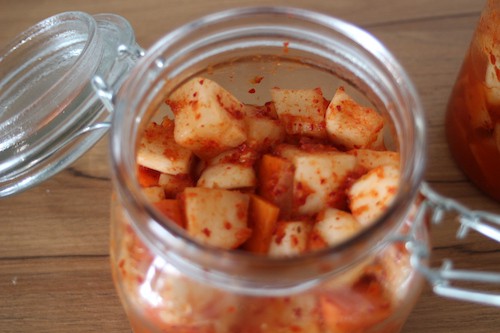
- To ferment the turnip kimchi, you'll need a large jar as the turnips take up quite a bit of space. Press down all of the turnips and carrots with a spoon and leave the lid loose. Place the jar in a cool and dark place for 2 days to allow the lacto-fermentation process to occur. It's important to periodically check on the kimchi during this time and press down the vegetables to ensure they are submerged in the brine.
Tips Before You Go
This Turnip Kimchi Kkakdugi with Carrots recipe is an easy and healthy way to enjoy the benefits of fermented foods while indulging in a delicious dish. Remember to rinse the vegetables thoroughly before slicing and use ginger sparingly to avoid overpowering the other flavors.
To keep the kimchi fresh, store it in a sealed container in the refrigerator, where it will continue to ferment and develop its flavors. You can also add it to other dishes, such as rice bowls or stir-fries, to add a tangy kick.
As for side dish suggestions, try serving this Turnip Kimchi alongside some steamed rice or with a protein of your choice, such as grilled chicken or tofu. I like to pair it with other Korean dishes, such as kimchi fried rice or bibimbap, for a complete meal.

Alicia Harper is a NASM-CNC Certified nutritionist and the editor of ProbioticReviewGirl.
After suffering from recurrent gut issues she spent years researching Probiotics and the microbiome.
She has tested 29+ different Probiotics and is a probiotics expert. As a probiotic fanatic, she has valuable knowledge to share with the world.